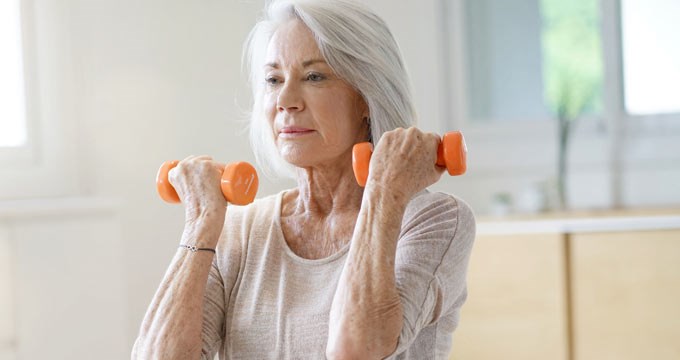Regular exercise isn’t just for athletes and fitness fans, it is important for everyone at every age to maintain a healthy body and mind.
Adults who take part in regular exercise have a lower risk of developing a range of health conditions, including bowel cancer, breast cancer, coronary heart disease, dementia, hip fractures, osteoarthritis, stroke and type 2 diabetes. They also tend to live longer than those who do not exercise regularly and in later years are less likely to experience falls.
Regular exercise also helps boost your mood, reduce your risk of depression and improve your sleep.
Here, we will take a look at how much and how often you should exercise, as well as what types of exercise are best for particular aspects of your health.
How much exercise do you need to stay healthy?
How much time you need to spend exercising depends on the intensity of the exercise.
For vigorous-intensity exercise, aim for 75 minutes spread throughout the week. This refers to exercise that gets your heart rate up to 70–85% of its maximum — you can calculate your maximum heart rate by taking away your age from 220. In practice, vigorous-intensity refers to exercise that only allows you to say a few words before you have to stop to catch your breath.
For moderate-intensity exercise, aim for 150 minutes spread throughout the week. This refers to exercise that gets your heart rate up to 50–60% of its maximum. In practice, this refers to exercise that still allows you to talk but not sing while you are exercising
Although it is recommended that you spread your exercise across multiple days in the week for maximum health benefits, you will still benefit considerably from exercise even if you fit it all into the weekend.
It’s important to note that if you’re not used to exercising regularly, you should gradually increase your fitness level by exercising for slightly longer each week and slowly increasing the intensity of your exercise. This will give your body time to adjust and reduce your risk of injury.
Similarly, if you have any health conditions that affect your ability to exercise, such as cardiovascular or respiratory conditions or muscle or ligament injuries, you should speak to your GP before starting a new exercise regime.
Different types of exercise for your health
Exercise can broadly be divided into aerobic exercise (also known as cardio), strength training, stretching and balance exercises. Incorporating each of these different types of exercise will help maintain different aspects of your health.
Aerobic exercise
This refers to exercises that raise your heart rate and breathing rate. Aerobic exercise should be a part of your regular exercise routine. It increases your endurance and helps lower your blood pressure, blood sugar and LDL (‘bad’) cholesterol levels.
This type of exercise is, therefore, ideal for losing weight, including belly fat, as well as reducing your risk of heart disease, stroke, type 2 diabetes and certain cancers. It also supports your mental health by releasing hormones called endorphins. This reduces your risk of anxiety and depression.
Examples of aerobic exercise include swimming, running, rowing, brisk walking, marching on the spot, walking up stairs and dancing.
Strength training
This refers to exercises that strengthen your muscles; not only your biceps, quadriceps and calves but also your core muscles. Core muscles are the muscles around the centre of your body in your abdomen, pelvis and hips. Strengthening all of these muscles strengthens your bones and improves your balance and posture, which together can help reduce joint pain.
Strength training also helps lower your blood sugar levels and maintain a healthy weight, which together reduce your risk of type 2 diabetes.
Try to take part in strength training at least twice a week. Strength-training exercises include lifting weights, using resistance bands, squats, pushups, lunges and pull ups, as well as everyday activities like carrying heavy shopping, carrying a child and heavy gardening.
Stretching
Regular stretching improves the flexibility of your muscles and tendons (the tissue that connects your muscles to your bones). This can help reduce joint pain, muscle pain and muscle cramps. It also improves your range of motion, which reduces your risk of damaging your muscles and tendons when moving.
Stretching should be carried out every time you exercise as part of your pre- and post-exercise routine ie warming up and cooling down.
Dynamic stretching exercises are ideal for warming up. This refers to repetitive movements, such as marching on the spot, arms circles, hip circles, jumping jacks and leg swings.
Static stretching exercises are ideal for cooling down. This refers to holding parts of your body in a stretched position for up to 30 seconds. Be careful not to overstretch; although you should feel the stretch, it should not feel painful.
Balance exercises
Although balance exercises are often associated with older adults to help prevent falls, they are useful at any age and improve muscle coordination and strength. Consequently, if you play sports, they can improve your athletic performance.
Examples of balance exercises include walking heel to toe, standing on one foot and raising the other leg up and down, stationary lunges and split squats.

Workout ideas for low, medium and high-intensity exercise
Low-intensity exercise
If you're new to regular exercise, it helps to start with a low-intensity workout. This could be as simple as going for a walk or jogging on flat terrain. You can gradually increase the distance you travel and start walking up and downhill when you’re ready to increase the intensity of your exercise.
Other low-intensity forms of exercise include cycling and swimming at a relaxed pace or using an elliptical machine or treadmill at a slower setting.
Moderate-intensity exercise
A moderate-intensity workout could include brisk walking, dancing, hiking, running or playing tennis, football or another active sport. You can gradually increase the speed and/or duration of your workout to increase its intensity.
High-intensity exercise
Once you feel comfortable with moderate-intensity exercise, you may want to try a more vigorous workout, such as high-intensity interval training (HIIT). This refers to any exercise routine that incorporates short periods of very intense exercise interspersed with short breaks.
Examples of HIIT could include various combinations of squats, jumping lunges, burpees and push ups performed in quick succession followed by a short break, after which the cycle repeats.
Vigorous-intensity exercise can also be more intense versions of your usual moderate-intensity workouts eg running faster, for longer and/or on a steeper incline, or swimming more laps in a given period of time.
Exercises for older adults
As you age, it is still important to keep up with a regular exercise routine. However, you may find that higher intensity exercise is too challenging. It is important to be aware of your fitness and energy levels so you don’t become overtired.
With age, you may also develop certain conditions that require you to adapt your exercise routine. For example, if you have osteoarthritis, you may need to avoid high-impact activities such as jumping or sudden twisting and turning as these can put greater strain on your joints.
To maintain a healthy body as you get older, it is important to focus on exercises that reduce your risk of falls. This includes exercises that strengthen your core muscles and leg muscles, and improve your balance. This can be as simple as going for regular walks — as this is also a weight-bearing exercise, it can strengthen your bones to reduce your risk of osteoporosis.
It is also helpful to focus on exercises that improve your flexibility as your muscles shorten and lose mass as you get older, which can lead to stiffness. Yoga, Pilates and tai chi can all help with this and there are often seated versions of these exercises if you don’t have the stamina for standing exercises.
How to exercise safely
Whatever your age, it is important to exercise safely to reduce your risk of injury. Be aware of your personal fitness level rather than comparing yourself to your peers and make sure you don’t overdo it. While it is important to gradually push yourself to improve your fitness, this shouldn’t be done too quickly or intensely.
If you have any pre-existing health conditions that could have an impact on your ability to exercise (eg cardiovascular disease, respiratory problems or issues with your bones and joints), always speak to your GP first before starting a new exercise regime.
To ensure you get the most out of your exercise, follow a healthy, balanced diet so your body has the right fuel to build strength and endurance. However, try to avoid exercising for at least 30 minutes after a snack and 1–2 hours after a meal. It is also important to stay hydrated while you exercise.
Finally, always warm up before exercise and cool down afterwards, and wear comfortable, breathable clothing and supportive shoes.

